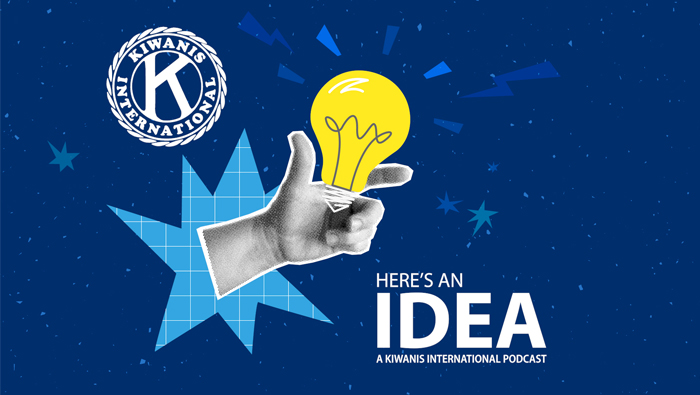


Success through socials
Jerrod Goldsmith discusses his club’s recruiting success through monthly social events.

Bring hope to unhoused young people
To address youth homelessness, get inspiration from these Kiwanis family projects.
By Julie Saetre and Erin Chandler
November is Youth Homelessness Outreach, Prevention and Education (HOPE) Month. Each year, according to the National Runaway Safeline, an estimated 4.2 million young people ages 13-25 experience homelessness — in the United States alone. And each year, members of the Kiwanis family organize service projects to help.
Want some inspiration for your club? Use these Kiwanis family examples — and research the needs of youth experiencing homelessness in your city or district.
The Kiwanis New Jersey District: Project on Youth Homelessness
After Kiwanians in the U.S. state of New Jersey identified youth homelessness as a serious concern in the district, they learned that shelter, support and other vital social services were often underfunded. Sometimes the needs of these young people were overlooked entirely.
In response, the Kiwanis New Jersey District adopted a project for its Kiwanis clubs over the 2024-25 and 2025-26 service years: to contribute US$20,000 in funds and complete 2,000 hours of community service with agencies serving unhoused youth in the state.
In addition, the New Jersey Kiwanis Foundation committed to expand the project’s impact in local communities by providing up to US$45,000 in matching and capital improvement grants to youth homeless shelters throughout the state during the same time period. – Julie Saetre
York Castle High School Key Club: Strathmore Children’s Home Initiative
In Saint Ann, Jamaica, the members of York Castle High School Key Club are reaching out to help vulnerable children in their community with support from a 2025 Youth Opportunities Fund grant. The club pledges to revitalize Strathmore Children’s Home — a nonprofit that houses children with disabilities, those who have been abandoned, and wards of the state — with new security gates, paint, tiles and a community garden. Members also will provide essential supplies such as food and hygiene products. Altogether, this initiative will make Strathmore Children’s Home a safer and more welcoming place for residents and staff for years to come. – Erin Chandler
Northwest Indianapolis Kiwanis Club: Snacks for Homeless Students
More than a decade ago, members of the Northwest Indianapolis Kiwanis Club in Indiana, U.S., discovered that over 160 students at a local high school were unhoused and hungry. And more students were suffering the same problem throughout the local school district. So the club began collecting nonperishable items and monetary donations for the school district’s food pantry, including prepackaged snacks that are easier for the kids to eat on the run. During the last five years, which have included the COVID-19 pandemic and economic challenges, the pantry has expanded its support to assist students’ neighbors as well — and the Northwest Indianapolis club continues to do its part to help. – JS
Circle K International Club of Northern Arizona University: Care Without Conditions
Members of the Northern Arizona University CKI Club in Arizona, U.S., are helping their community’s unhoused population — including fellow students — by assembling and distributing care packages containing hygiene products, nonperishable snacks, socks, bottled water and more. Each package also includes a handmade card and a guide to local resources, including shelters, food banks and healthcare services. Club members hope the care packages will bridge the gap between people experiencing homelessness and the larger university community. – EC
Key Club of Desert Oasis High School: Care Kits for Kids
In Nevada, U.S., the Key Club of Desert Oasis High School is helping youth who are experiencing homelessness in Las Vegas. The club will assemble different types of care kits — hygiene kits containing travel-sized toiletries; holiday gift kits with items such as phone chargers, journals, blankets, socks and more; and snack kits containing canned meats, fruit, granola bars, chips and juice— to offer care, support and hope to young people. The club will donate kits to local homeless and youth centers. – EC
The Atascadero Kiwanis Aktion Club/Gum Springs Elementary School K-Kids: Blankets for those in need
The Atascadero Kiwanis Aktion Club in California, U.S., donated 20 handmade, handtied blankets to children staying at the El Camino Homeless Organization (ECHO) shelter, which provides safe and secure overnight shelter to families facing hunger and homelessness.
“Receiving these beautiful handmade blankets means so much to the children and families we serve,” ECHO CEO Wendy Lewis told club members. “The care and effort the Aktion Club members put into creating them truly embodies the spirit of community and compassion.”
In Georgia, U.S., the K-Kids of Gum Springs Elementary School did their part to give the gift of warmth. They brought in pairs of blankets, which were then tied together to make insulated blankets. The assembled blankets then were distributed to people without access to warm shelters. – JS
